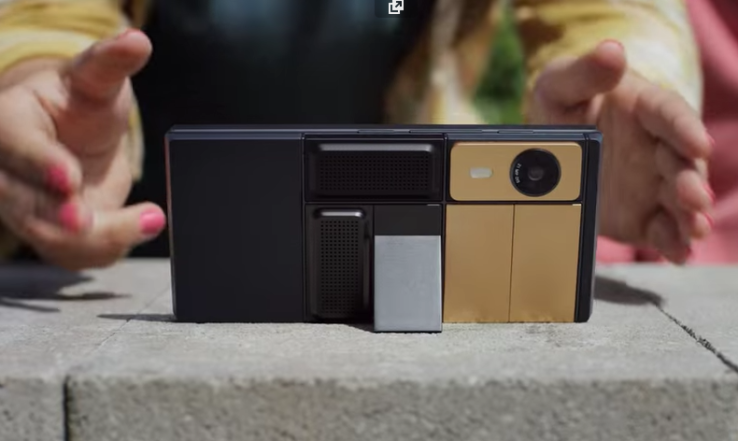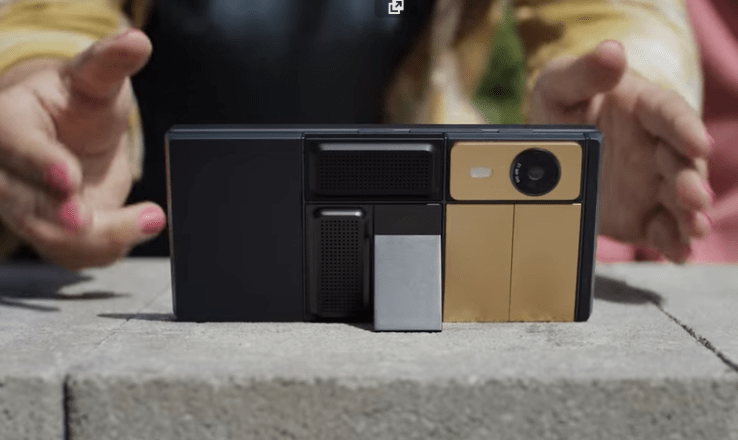

File it under ‘it seemed great on paper’… but Google’s project Ara modular smartphone concept is — for all intents and purposes — dead.
If you want to be a little more generous, you can say Google has pivoted away from attempting to engineer the impossible — i.e. total smartphone modularity — to strip it back to a few swappable units that will not include core phone components.
And that’s assuming its latest prototype ever makes it to market, as none of its Ara predecessors have.
The prototype Google was showing off at I/O last week, now pledging a 2017 commercial release for a modular phone it’s been working to bring to market since at least 2013, will apparently have six spaces on the back for swappable modules.
A camera, a speaker and an e-ink display are some of the early ideas for modules that Google is talking about, although it says it intends to open this up to let third parties build stuff.
The head of creative and marketing for the ATAP skunkworks lab, which the project falls under at Google/Alphabet, anticipates hardware hackers building “crazy stuff” to squeeze into Ara’s sockets.
And crazy is the word because modularity is necessarily a minority passion. The mainstream isn’t half so keen on needing to physically configure their high tech kit before they can use it as they wish (vs the geek fraternity voluntarily spending all their spare hours doing exactly that).
Even lead Ara engineer, Rafa Camargo, confessed as much himself in an interview with CNET. “When we did our user studies, what we found is that most users don’t care about modularizing the core functions. They expect them all to be there, to always work, and to be consistent,” he said.
Key phrases there: ‘Always work’. ‘Be consistent’.
In other words, the exact opposite of modularity.
And still Google pushes Ara.
The new party trick for Ara shown off on stage at I/O is a voice command that lets the user eject a swappable camera module by saying ‘Ok Google eject the camera’ — garnering much applause from the developer crowd at the event.
But Google using a publicity-prone yet impractical non-commercial gizmo to showcase another, far more core piece of its tech (voice-based interfaces) is standard playbook for such a savvy marketing entity. (StreetView cameras strapped to hikers anyone?)
And perhaps explains why Ara has gone the distance at Google yet never shipped.
The dream of the modular smartphone yielding completely customizable consumer handsets always seems far more enticing than the reality of demanding, prone to falling apart prototypes. But if the engineering challenge is hideous, the consumer reality is even more unappealing. Fiddly bits of phone that get misplaced or lost down the back of the sofa… Er, tell me again why it’s a good idea to make a smartphone more complicated to use?
And why, as a consumer, would you want your smartphone to not have a decent camera/audio performance in the first place? That’s the great conjuring conceal of Ara-style modularity — ‘buy this not very good device, and then pay more to make it a bit better!’
When it comes to adding extra functionality via modules, i.e. not just improving an existing set of core phone features, then the promise is to support niche use-cases — say by adding an environmental sensor module — which is necessarily of minority, not mass, appeal.
And why do you need a sensor to be plugged into the back of the phone anyway? The huge spectrum of extant Bluetooth IoT add-ons that link to a mobile or tablet without needing to be physically plugged into that device makes Ara’s promise of plug-and-play sensor modules at best incrementally interesting.
The e-ink screen module is perhaps the most compelling idea here IMO. But Yota Devices has been attempting to drive interest in dual-display e-ink smartphones for years. Cool? Absolutely. Mainstream appeal? Absolutely not.
Ok then, what about affordability? At one point Google was talking about the base Ara hardware being $50, which sounded surprisingly cheap (at the time). Albeit you’d still need to factor in module costs…
At first glance, modularity might look like an interesting avenue to explore if making phones more affordable is your key driver — as a way to expand the range of features in a low cost basic device by enabling the buyer to spread the cost with modular add-ons.
But given the engineering complexity of building a robust base for modules to plug into and play nicely with, and the fact Google is not specifying how much add-on modules will cost at this point, ‘huge affordability’ is not really looking like it’s in Ara’s box of add-on tricks.
At the same time, low cost smartphones continue to become more capable as higher end specs and features are squeezed further down the price continuum by a hyper competitive, face-paced smartphone market. So modularity looks like a very slow, sub-par ‘solution’ — if solution it be — to affordability.
The original inspiration behind Ara was in fact another concept called Phonebloks — which was motivated by a recycling/reuse agenda, with a stated aim of wanting to ‘change the way electronics are made in order to create less waste’. Which is certainly a whole lot more interesting as an idea. But it is not, apparently, the direction Google is pushing Ara in.
Au contraire Ara’s slimmed down modularity now appears aimed at creating more electronic stuff per person/smartphone, by selling a pick ‘n’ mix of additional hardware bits and thereby encouraging an expanding of the electronics-plus-plastics pie.
And if Google is thinking that custom add-ons could be a way to spin out the lifespan of a single smartphone, by encouraging people to hold onto a handset for longer and thereby decrease total upgrade wastage over the longer term, well it’s not making a big song and dance about that being its mission as yet. So we’ll have to wait and see.
Meanwhile, a very different company has (quietly) made that sort of modularity a reality. Step forward Fairphone whose Fairphone 2 Android smartphone, which you can buy today (for €525), is “designed for repairability” — with a series of modules that can be swapped out when you need a new processor, say, or display. The spare parts (aka swappable modules) are sold in its online shop…
Surely this more practical, less flashy ‘modularity for sustainability’ is something Google could have pushed for with Ara. And could have played a leadership role in encouraging Android OEMs to look towards the circular economy for their next-gen product inspiration.
Instead it went down (and remains within) a modular rabbit hole, producing a series of fantastical prototype demos and concept videos along the way which have really only been feeding its own publicity agenda at this point… ‘Oh look at the cute/crazy stuff Google is making now!’ etc etc.
It is true Mountain View is not the only company dabbling with consumer modularity in smartphones. Back in February LG unveiled a smartphone with a swappable nodule on its bottom end. To less than great reviews. And no obvious tsunami of consumer interest. Even so LG clearly thought it worth a punt bringing a modularity-lite concept to market.
But then to stand out in the fiercely competitive smartphone market Android OEMs are having to pull out all the stops — including, apparently, offering consumers the choice to pull off and swap out the rump of their phone. File that one under ‘fiddly gimmick’.
Of course Google has even more incentive than LG to keep Android feeling fresh and funky, given the platform is the dominant smartphone OS by a huge margin — and Google obviously wants to keep it that way. So you could say there’s an element of ‘sustainability’ in its modular thinking with project Ara. But just a more self-serving kind that aims to keep developers enthused and perceptions tickled.
So if/when Ara ships ‘some time’ in 2017, as it’s now billed to, even though the phone will in all likelihood sell only in tiny quantities to niche, enthusiast buyers, the project will have done its bit for its parent entity by feeding the company’s wider brand narrative for multiple years. And that’s a mission Google/Alphabet is of course 100% committed to.

